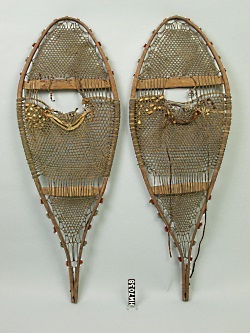
Photo Courtesy & Copyright Hudson Museum, University of Maine
Imagine yourself living in Utah hundreds of years ago – before cars, before horses, before European influences. Summers provide you with abundant game and a multitude of plants for food and other materials, but the winters are harsh and full of snow. How did Native Americans manage to survive winter without modern amenities like snow plows and grocery stores? These hearty individuals owe their ability to hunt and travel in our snowy climate to one important tool – the snowshoe.
Snowshoes have been a part of life for humans in cold-weather climates for at least 6,000 years. From what historians can tell, people living in central Asia learned to strap thin planks of wood to their feet in order to help them travel through deep snow. Snowshoes work by increasing the surface area of the wearer’s foot, which distributes his or her weight across more snow – allowing them to basically float on top of the snow.

Indian Snowshoes. circa 1890 – 1920.
Photo Courtesy & Copyright VintageWinter.com
From this common ancestor in central Asia, both snowshoes and skis arose. Over the years, people began to spread out and move to new locations. Those who went west, into Europe, eventually developed the ski and those who went east across Siberia and into the Americas developed the snowshoe. The early snowshoes used by Native Americans were constructed of a wooden frame which was laced with babiche, un-tanned animal hide.
While we will likely never know why that first person decided to strap a plank of wood to their foot, perhaps they took their cue from Mother Nature. You see, humans are not the only ones who have figured out how to keep ourselves afloat on snow – some members of the animal world have too, and Utah holds two standout examples: the aptly named snowshoe hare and the Canada lynx. Both of these animals have extraordinarily large feet, which act much the same as our snowshoes, distributing the animal’s weight across a larger surface area.
Perhaps it’s no coincidence that both snowshoe hares and Canada lynx share this amazing adaptation. These two species are closely connected to each other in a special relationship: that of predator and prey. Leaving us to ponder the question: whose snowshoes came first, the lynx or the hare?

Photo Courtesy & Copyright VintageWinter.com
For more information and photos of traditional snowshoes, please visit our website at www.wildaboututah.org. Thank you to the Rocky Mountain Power Foundation for supporting the research and development of this Wild About Utah topic.
For the Stokes Nature Center and Wild About Utah, this is Andrea Liberatore.
Credits:
Photos: Courtesy Hudson Museum,
University of Maine
www.umaine.edu/hudsonmuseum/
Nick Thomas, SkiEO, VintageWinter www.vintagewinter.com
Text: Andrea Liberatore, Stokes Nature Center

Visit the Vintage Winter Sports Museum
Courtesy & Copyright VintageWinter.com
Additional Reading:
Prater, Gene. 1998. Snowshoeing, 3rd Edition. Seattle: The Mountaineers
Zeveloff, Samuel I. 1988. Mammals of the Intermountain West. Salt Lake City: University of Utah Press
